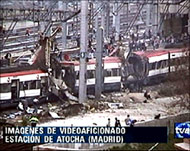Searching for Spain’s ‘guardian angels’
A white beard and green uniform is all Zahira can remember of the man who rescued her from the wreckage of the Madrid commuter train where a bomb destroyed half her face and one eye.

But the 21-year-old still hopes she can locate him somewhere among Madrid’s nearly three million inhabitants, more than a month after the attack which maimed her – with the help of an Internet site.
The site, whose address www.quienmeayudo.com translates as “who helped me.com”, aims to bring victims together with the people who, in the words of one injured 44-year-old, “descended into hell” to rescue them.
Lists of names, ages, heights and hair and skin colour are followed by poignant accounts of the carnage that claimed 191 lives on 11 March when bombs exploded on four packed early-morning commuter trains.
The attacks injured 1900 people.
“Hello, I am the husband of Ana Isabel, a dark woman with mid-length hair who was at a late stage of pregnancy… Unfortunately my wife and our child passed away in the Paz hospital,” writes 29-year-old Jesus, searching for anyone who
saw or helped his dying wife.
|
“Hello, I am the husband of Ana Isabel, a dark woman with mid-length hair who was at a late stage of pregnancy… Unfortunately my wife and our child passed away in the Paz hospital” |
The site, whose front page features only the simple black ribbon that has become a ubiquitous sign of solidarity and mourning in Spain, was set up by three media professionals, moved by dozens of victims wanting to trace their rescuers.
“The wounded, when they appeared on television, always seemed to be asking ‘who helped save me’,” said one of them, who asked to remain anonymous to keep the focus on victims.
Rescuers and victims
The three are paying for and running the Web site, and say
that although adding new entries and putting hopeful rescuers and victims in touch takes up much of their spare time, they are committed to keeping it going.
Eighty-two victims and helpers have so far registered their details.
Rescuers, haunted by the fate of the badly injured they tried to help save, also have a page.
 |
|
Victims are keen to meet the |
“I can’t stop thinking about how Susana [I didn’t ask for her last name] is … she had been thrown to the floor, and was bleeding from her head and mouth,” wrote a woman who had been travelling in one of the trains that was attacked.
“I try not to think about March 11, but I worry about how Susana is.”
The Web site is just part of an outpouring of support by ordinary Spaniards – from the bus driver who turned his bus into an impromptu ambulance to the psychologists who crowded morgues offering to counsel survivors and families.
Now a shocked and grieving Madrid, with black ribbons still fluttering from thousands of windows and car aerials, wants to thank its anonymous helpers.
The advertising hoardings in metro stations have been taken over by enormous posters proclaiming: “Madrid is grateful”.